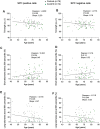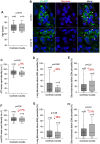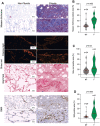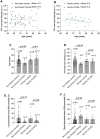Short telomeres in alveolar type II cells associate with lung fibrosis in post COVID-19 patients with cancer
- PMID: 37294548
- PMCID: PMC10292892
- DOI: 10.18632/aging.204755
Short telomeres in alveolar type II cells associate with lung fibrosis in post COVID-19 patients with cancer
Abstract
The severe acute respiratory syndrome coronavirus 2 (SARS-CoV-2) is responsible for the coronavirus disease 2019 (COVID-19) pandemic. The severity of COVID-19 increases with each decade of life, a phenomenon that suggest that organismal aging contributes to the fatality of the disease. In this regard, we and others have previously shown that COVID-19 severity correlates with shorter telomeres, a molecular determinant of aging, in patient's leukocytes. Lung injury is a predominant feature of acute SARS-CoV-2 infection that can further progress to lung fibrosis in post-COVID-19 patients. Short or dysfunctional telomeres in Alveolar type II (ATII) cells are sufficient to induce pulmonary fibrosis in mouse and humans. Here, we analyze telomere length and the histopathology of lung biopsies from a cohort of alive post-COVID-19 patients and a cohort of age-matched controls with lung cancer. We found loss of ATII cellularity and shorter telomeres in ATII cells concomitant with a marked increase in fibrotic lung parenchyma remodeling in post- COVID-19 patients compared to controls. These findings reveal a link between presence of short telomeres in ATII cells and long-term lung fibrosis sequel in Post-COVID-19 patients.
Keywords: ATII cells; COVID-19; SARS-CoV2; lung fibrosis; telomeres.
Conflict of interest statement
Figures





Similar articles
-
Telomere dysfunction in alveolar epithelial cells causes lung remodeling and fibrosis.JCI Insight. 2016 Sep 8;1(14):e86704. doi: 10.1172/jci.insight.86704. JCI Insight. 2016. PMID: 27699234 Free PMC article.
-
Therapeutic effects of telomerase in mice with pulmonary fibrosis induced by damage to the lungs and short telomeres.Elife. 2018 Jan 30;7:e31299. doi: 10.7554/eLife.31299. Elife. 2018. PMID: 29378675 Free PMC article.
-
The Defenders of the Alveolus Succumb in COVID-19 Pneumonia to SARS-CoV-2 and Necroptosis, Pyroptosis, and PANoptosis.J Infect Dis. 2023 May 29;227(11):1245-1254. doi: 10.1093/infdis/jiad056. J Infect Dis. 2023. PMID: 36869698 Free PMC article.
-
COVID-19 and pulmonary fibrosis: A potential role for lung epithelial cells and fibroblasts.Immunol Rev. 2021 Jul;302(1):228-240. doi: 10.1111/imr.12977. Epub 2021 May 24. Immunol Rev. 2021. PMID: 34028807 Free PMC article. Review.
-
Potential mechanisms for lung fibrosis associated with COVID-19 infection.QJM. 2023 Jul 28;116(7):487-492. doi: 10.1093/qjmed/hcac206. QJM. 2023. PMID: 36018274 Free PMC article. Review.
Cited by
-
Revealing the Hidden Impacts: Insights into Biological Aging and Long-Term Effects in Pauci- and Asymptomatic COVID-19 Healthcare Workers.Int J Mol Sci. 2024 Jul 24;25(15):8056. doi: 10.3390/ijms25158056. Int J Mol Sci. 2024. PMID: 39125624 Free PMC article.
-
Longer ICU stay and invasive mechanical ventilation accelerate telomere shortening in COVID-19 patients 1 year after recovery.Crit Care. 2024 Aug 7;28(1):267. doi: 10.1186/s13054-024-05051-6. Crit Care. 2024. PMID: 39113075 Free PMC article.
-
The context-dependent effect of cellular senescence: From embryogenesis and wound healing to aging.Ageing Res Rev. 2025 Jul;109:102760. doi: 10.1016/j.arr.2025.102760. Epub 2025 May 1. Ageing Res Rev. 2025. PMID: 40318767 Review.
-
Peripheral and pulmonary telomere lengths in patients with non-idiopathic pulmonary fibrosis interstitial lung diseases.BMC Pulm Med. 2025 Aug 1;25(1):368. doi: 10.1186/s12890-025-03865-w. BMC Pulm Med. 2025. PMID: 40751243 Free PMC article.
-
Activation of senescence in critically ill patients: mechanisms, consequences and therapeutic opportunities.Ann Intensive Care. 2024 Jan 5;14(1):2. doi: 10.1186/s13613-023-01236-4. Ann Intensive Care. 2024. PMID: 38180573 Free PMC article. Review.
References
Publication types
MeSH terms
LinkOut - more resources
Full Text Sources
Medical
Miscellaneous

